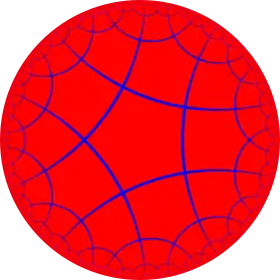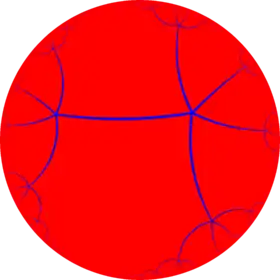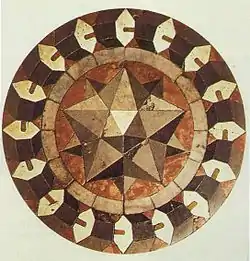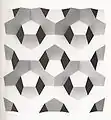| Infinite-order pentagonal tiling | |
|---|---|
 Poincaré disk model of the hyperbolic plane | |
| Type | Hyperbolic regular tiling |
| Vertex configuration | 5∞ |
| Schläfli symbol | {5,∞} |
| Wythoff symbol | ∞ | 5 2 |
| Coxeter diagram | |
| Symmetry group | [∞,5], (*∞52) |
| Dual | Order-5 apeirogonal tiling |
| Properties | Vertex-transitive, edge-transitive, face-transitive |
In 2-dimensional hyperbolic geometry, the infinite-order pentagonal tiling is a regular tiling. It has Schläfli symbol of {5,∞}. All vertices are ideal, located at "infinity", seen on the boundary of the Poincaré hyperbolic disk projection.
Symmetry
There is a half symmetry form, ![]()
![]()
![]()
![]() , seen with alternating colors:
, seen with alternating colors:
Related polyhedra and tiling
This tiling is topologically related as a part of sequence of regular polyhedra and tilings with vertex figure (5n).
| Finite | Compact hyperbolic | Paracompact | ||||
|---|---|---|---|---|---|---|
 {5,3} |
 {5,4} |
 {5,5} |
 {5,6} |
 {5,7} |
 {5,8}... |
 {5,∞} |
| Paracompact uniform apeirogonal/pentagonal tilings | |||||||||||
|---|---|---|---|---|---|---|---|---|---|---|---|
| Symmetry: [∞,5], (*∞52) | [∞,5]+ (∞52) |
[1+,∞,5] (*∞55) |
[∞,5+] (5*∞) | ||||||||
 |
 |
 |
 |
 |
 |
 |
 |
 |
|||
| {∞,5} | t{∞,5} | r{∞,5} | 2t{∞,5}=t{5,∞} | 2r{∞,5}={5,∞} | rr{∞,5} | tr{∞,5} | sr{∞,5} | h{∞,5} | h2{∞,5} | s{5,∞} | |
| Uniform duals | |||||||||||
 |
 |
 |
 |
||||||||
| V∞5 | V5.∞.∞ | V5.∞.5.∞ | V∞.10.10 | V5∞ | V4.5.4.∞ | V4.10.∞ | V3.3.5.3.∞ | V(∞.5)5 | V3.5.3.5.3.∞ | ||
See also
Wikimedia Commons has media related to Infinite-order pentagonal tiling.
References
- John H. Conway; Heidi Burgiel; Chaim Goodman-Strauss (2008). "Chapter 19, The Hyperbolic Archimedean Tessellations". The Symmetries of Things. ISBN 978-1-56881-220-5.
- H. S. M. Coxeter (1999). "Chapter 10: Regular honeycombs in hyperbolic space". The Beauty of Geometry: Twelve Essays. Dover Publications. ISBN 0-486-40919-8. LCCN 99035678.
External links
This article is issued from Wikipedia. The text is licensed under Creative Commons - Attribution - Sharealike. Additional terms may apply for the media files.


